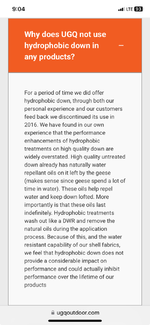I hope this video surprises you all as much as it surprised me. This isn't a scientific study, but the fact that untreated down performed better than treated down when submerged in water wasn't something I expected to happen. And to make it even more interesting, treated down took longer to dry out. And yes, we could have submerged the down samples for longer and perhaps seen different results. I'll leave future tests to other people.
When we were devleoping our sleeping bag, I decided I was tired of being told by other brands/people etc. how treated and untreated down would perform against each other in water and decided to do my own homework. IMO, this confirmed my suspicions that most of the hype around treated down is largely bogus when you think about real world application.
When we were devleoping our sleeping bag, I decided I was tired of being told by other brands/people etc. how treated and untreated down would perform against each other in water and decided to do my own homework. IMO, this confirmed my suspicions that most of the hype around treated down is largely bogus when you think about real world application.

